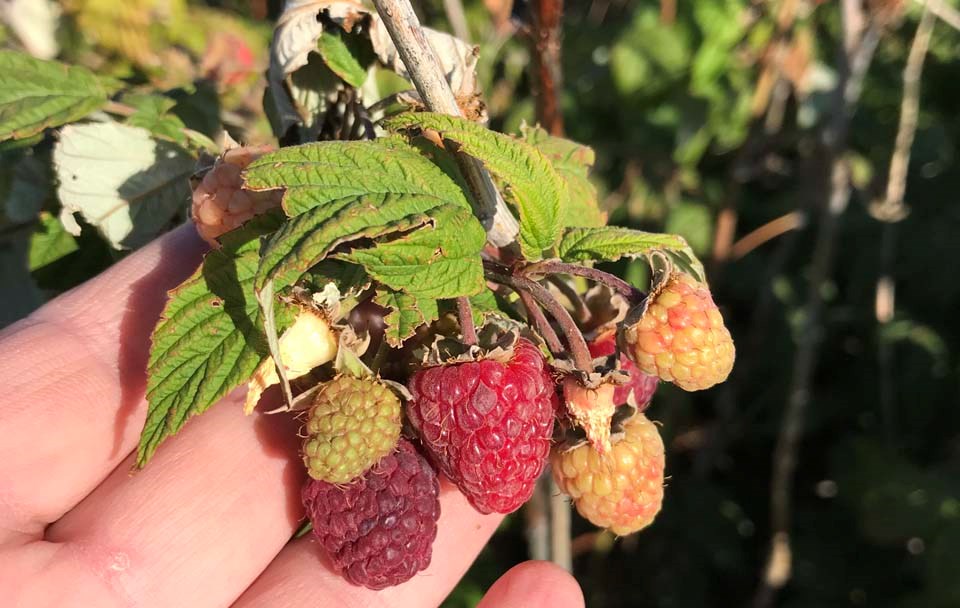Last week I picked my first pail of raspberries. The week before that, I was eating fresh haskap berries on my ice cream. I’ve had several handfuls of strawberries from my garden, but there are a lot more of those to come. It is definitely saskatoon berry picking season and soon the dwarf sour cherries will be ready, followed by more raspberries, plums and finally Prairie apples in the fall.
How do you know when it is the best time to harvest your Prairie fruit? Haskap berries are some of the earliest fruit to mature. Haskaps are ready to harvest when the outside of the berry has turned purplish/blue and the INSIDE of the berry has turned from green to reddish/purple. Many people pick their haskap as soon as the outer skin turns purple; however, the flavour and sweetness are optimal when the interior of the berry has also turned colour.
Strawberries are ready to harvest when they have turned completely red on the outside. Slightly underripe strawberries (have a green or white tinge on the fruit) will not have their best sweetness or texture. Strawberries that are left on the vine too long will start to rot or mold. Unripe strawberries do not ripen off the vine. June-bearing strawberries are ready for harvest from late June through July. Day-neutral strawberries produce most of their fruit in mid-late August and September, up to fall frost.
Hardy raspberries for the Prairies can be red or gold. Floricane raspberries produce berries on last year’s canes and are ready to harvest from mid-July through to August. Primocane raspberries produce fruit on this year’s cane growth and are not ready to harvest until late in the fall and through to fall frost. Raspberries are ready for harvest when the fruit has fully turned colour.
Saskatoon berries are ready to harvest in mid-late July. Each of the Saskatoon berry selections is ready at slightly different times. ‘Honeywood’, ‘Nelson’ and ‘Smoky’ are slightly later maturing cultivars. Harvest Saskatoon berries when they are dark purple. Some selections have very uneven ripening of berries on the same bush, so several pickings are required for a complete harvest. ‘Martin’ has the most evenly ripening berries.
Dwarf sour cherries are ready for harvest in early to mid-August. Many people pick their dwarf sour cherries too early, before the interior flesh has turned a dark red. Mature dwarf cherry fruit should be a deep red to black/red when ripe and the interior of the fruit must be dark red. ‘Valentine’ is an exception to this rule in that the outer skin remains a bright red; however, ‘Valentine’ is one of the later cultivars to mature and usually is not ready for harvest until mid-August. If your cherry fruit is days away from harvest and there is an extended rainy period in the forecast, consider picking your cherries before the rain event, since excessive moisture will split mature cherry fruit on the bush.
Plums are ready to harvest near the end of August. Each plum cultivar has a different outer skin and inner flesh colour when they are mature. Know which cultivar you are growing and what a ripe plum of that cultivar looks like at maturity to enjoy the optimal texture and flavour. A general rule of thumb for plums is that they are ready to harvest when the outer skin has a waxy bloom and the fruit is slightly soft to the touch.
Apples are ready to harvest in September. Some apples can even withstand a slight frost. Old cultivars of Prairie apples often do not store well or last long on the tree. Newer apple releases like ‘Prairie Sensation’ hold their flavour and texture much longer on the tree and in storage.
When you are eating some of those fresh Prairie fruits this season, remember to thank all of the innovative and hard-working horticulturalists who spent their lives making these wonderful fruits available to us today. Many of these people worked without much gratitude or financing over the last 130 years, but they had a vision and a dream and they pushed forward despite the odds. The University of Saskatchewan has had a very successful fruit breeding program for over 90 years and it continues to this day. This program has not been without assistance from outside people and sources.
The recent fruit cultivar, ‘Boreal Bliss’ haskap, was developed over the last fourteen years at the U of S but some of the genetics used in developing ‘Boreal Bliss’ (and all of the U of S haskap cultivars) came from haskap fruit selections that were made by a US fruit breeder (Dr. Maxine Thompson) decades before the release of this cultivar. Similarly, it was Les Kerr, the second field superintendent of the Sutherland Forestry nursery (currently known as the Saskatoon Forestry Farm and Zoo), who passed on the original crosses used in the U of S dwarf sour cherries back in the late 1950s and 1960s. It has taken a team of dedicated, meticulous and selfless people many decades and in many countries to produce some of the Prairie fruit that we take for granted today.
This column is provided courtesy of the Saskatchewan Perennial Society.
(SPS; [email protected]). Check our website (www.saskperennial.ca) or Facebook page (www.facebook.com/saskperennial) for a list of upcoming gardening events.




